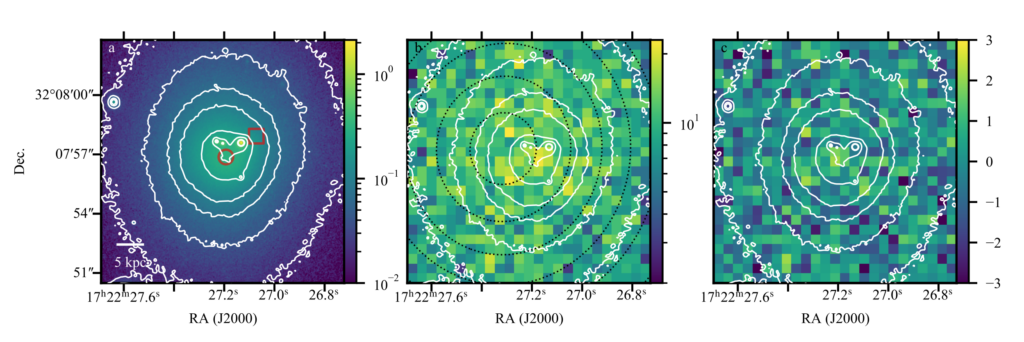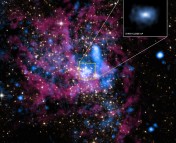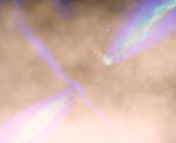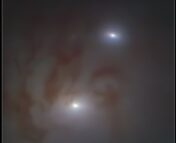Authors: K. Gültekin, S. Burke-Spolaor, T. R. Lauer, J. W. Lazio, L. A. Moustakas, P. Ogle, and M. Postman
First Author’s Institution: University of Michigan, Ann Arbor, MI, 48104, USA
Status: Accepted for publication in AAS Journals, open access on arXiv
Galaxies can come in many different shapes and sizes, from dwarf galaxies that contain only a few hundred million stars to giant spirals like the Andromeda Galaxy that house over a trillion stars. Their centers can also vary from noisy black holes emitting large jets of radiation (also known as active galactic nuclei) to two spiraling supermassive black holes from two merged galaxies. Today’s paper looks at a bright cluster galaxy and tries to figure out exactly what is at its center.
An odd galaxy
Though galaxies can look different, the galaxy cluster Abell 2261’s brightest cluster galaxy, A2261-BCG, is particularly strange-looking. It has a very large center in its stellar surface brightness profile, which looks at the brightness of the galaxy as a function of distance from the center, showing that the core is very large and flat. Interestingly, the core is offset from the center. Cores like this are sometimes the result of a supermassive black hole merger. When two galaxies collide, their central black holes can sink to the center of the merger and become a binary. Stars interacting with this supermassive black hole binary can even end up being flung out of the center, taking some energy from the binary with it, causing it to move closer together. This is called “scouring” a core in the galaxy. As the binary moves closer together, it will start to emit gravitational radiation in the form of gravitational waves. This energy emission from gravitational waves will eventually cause the supermassive black hole binary to merge, and can lead to a recoil of the merged black hole at speeds of up to several thousand kilometers per second(!), pushing it slightly away, or offset, from the center.
Astronomers expect that A2261-BCG should host a very massive black hole (which is possibly the result of a merged binary) at the center due to the size of its core. In this paper, the authors look for evidence of a recoiling or ejected black hole in AA2261-BCG, which would indicate that the black hole is a result of a merged binary.
Searching radio and X-ray observations
In order to test the theory that this supermassive black hole was once two, the authors focused on four stellar knots,areas of high star density, near the center. If the black hole was recoiling, it would take a clump of stars with it that it would be at the center of. In previous works, this team used the Very Large Array (VLA) telescope in New Mexico to look for radio emission coming from the stellar knots but the only activity they found was evidence of old jet activity. They then used the Hubble Space Telescope to look at the stellar velocity distributions of three of the knots to see if there was a massive object around, but didn’t find any conclusive evidence.
In this work, they use X-ray observations taken with the Chandra telescope to look for evidence of accretion onto a large black hole at the center of A2261-BCG. If found, it would point to the fact that the black hole has never recoiled or that the recoil is very slight.
Were they Abell to figure out what’s at the center?
The team analyzed new Chandra observations and performed image and spectral fitting on this data combined with archival data to determine the profile of the gas being emitted from the center. They found evidence of a previous dynamical disturbance, which matches their optical observations, but showed no point-source emission arising from the optical center of the galaxy. The observations show no solar mass black hole at any of the stellar knots (which is seen in Figure 1 by the absence of any excess emission from the stellar knots), which raises the question of just where the black hole is. One possibility is that it is at the center of the galaxy and is just accreting at such a low rate that it cannot be detected in X-rays. Another possibility is that the black hole traveled farther than 10 kpc away from the center, but looking farther away from the center could increase the chance of more X-ray noise.

The evidence of a radio source implies that at some point there was a sufficient amount of material falling onto the black hole to produce jets, but lack of evidence of a bright X-ray core supports the idea that this is relic emission and not current emission.
While the center should show some evidence for a supermassive black hole, the team finds that either there is no solar mass black hole at the center, or that it is accreting at a very low level. Further observations with the James Webb Space Telescope would allow two-dimensional spectral characterization of the core of the galaxy to help determine whether there is a black hole at the center of A2261-BCG.
Astrobite edited by: Brent Shapiro-Albert
Featured image credit: Gültekin et al. 2020 (part of Figure 1 from this paper)




